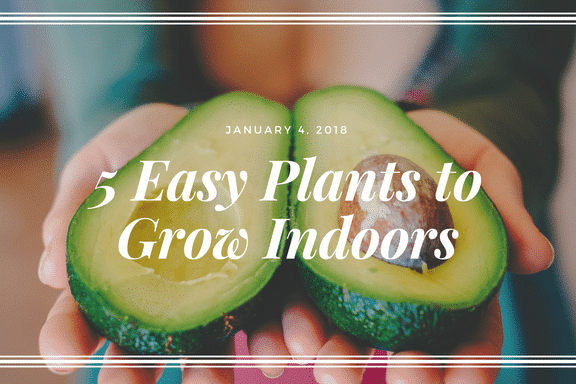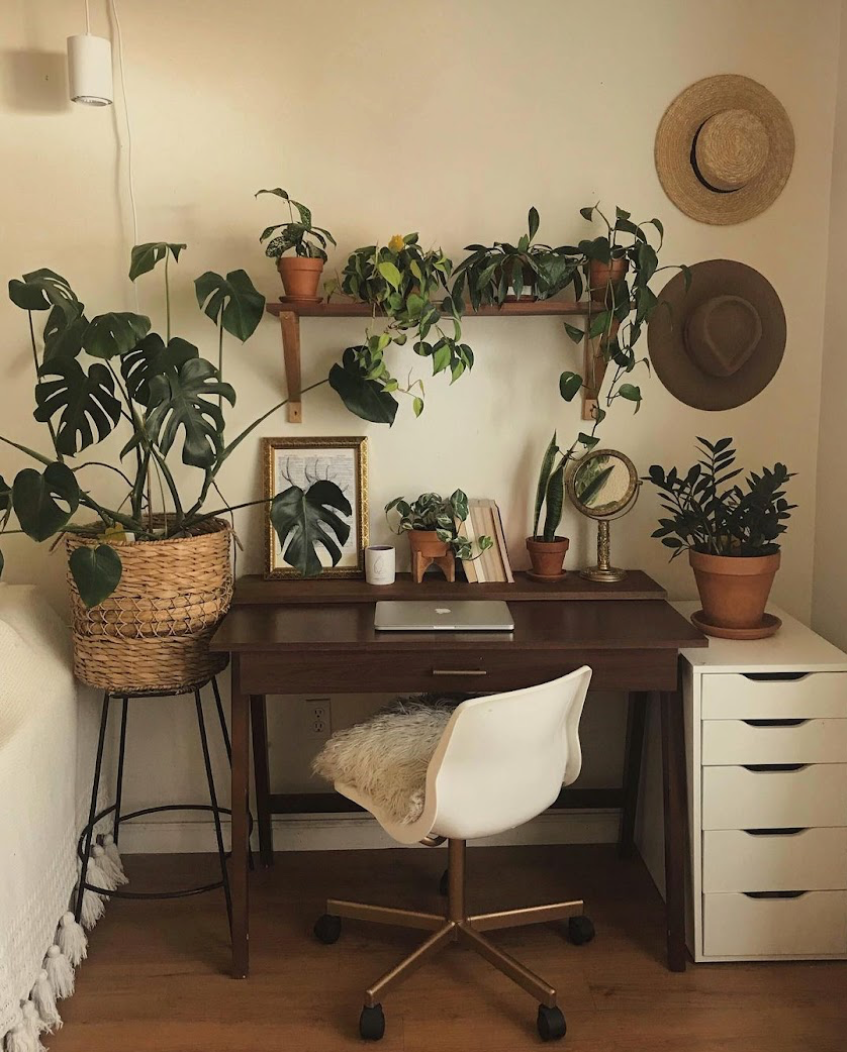
As the New Year kicks off, statistics show that up to 45% of us look to get in shape or eat healthier (I know I’m one of them) for our New Year’s Resolutions. Great, easy enough. Wrong. Unfortunately, by February almost 80% of us have failed resolutions or fallen through (again, guilty). We need that push of motivation to keep us from falling back on our typical tendencies we’re striving to stay away from, like grabbing quick easy food that isn’t necessarily the best option, just the most convenient at the time.
Here are some super easy fruit plants to grow indoors all while maintaining that healthy lifestyle you’re looking for. Best part? They’re grown in your home to compliment any type of lifestyle & enhance your interior design simultaneously.
1. Avocados
Not only are avocados extremely nourishing and delicious, but they’re super trendy to grow indoors. They’re a great alternative for healthy fats in your diet because they contain vitamins E, B6 & carotenoids, which are full of all kinds of good stuff. They’re high in vitamin A and have been linked to reduce the risk of cancer, heart disease, and long term vision. Hello superfood!
How to Grow Avocados Indoors:
There are two options to grow your new avocado plant. First, grow your tree from the pit of an avocado. This method can be tricky & is typically harder to yield edible fruit. In order to eat your avocado quicker, we recommend purchasing an avocado plant that ranges from dwarf, to larger green or black skinned fruits. Caring for your avocado tree is easy if you follow these simple steps. It’s best to use a compost combined with sand in order to create a fast draining, looser soil.
You want to water your tree regularly, without creating a soggy soil because the roots don’t take too well when waterlogged. This tree can grow quite high, up to 10 feet, so be sure to place it in an area with tall ceilings. Be sure to place your avocado tree under the an LED Plant Light so it receives equal lighting at all angles.
Harvesting Indoor Grown Avocados:
A green avocado plant is typically ready to harvest at a slightly yellow skin color, while darker fruits will have an almost black shade when ready. Avocados can hang on for a few weeks, but any longer and your fruit may lose its flavor and texture.
2. Lemons
Lemons symbolize cleanliness & good health, so what better fruit to incorporate into your home? Packed with vitamin C & tons of antioxidants, lemons are recognized to decrease heart disease risk, reduce inflammation and even fight some cancers. Imagine having a lemon tree in your kitchen for fresh additions to your meals & drinks at your convenience! This makes your New Year’s Resolution one step easier.
How to Grow Lemons Indoor:
Again, you have the luxury of picking a growing style to your preference. You can simply take a lemon seed and plant it in evenly moist soil, however this may take a while for initial harvest. For immediate harvest, the best option is to purchase a 2-3 year old dwarf tree at a nursery.
Make sure your pot has several holes in the bottom & fill the drainage dish with stones, allowing circulation. Your soil should be citrus tree specific for optimal growth and yield. Your lemon tree should be receiving 8-12 hours of light from an indoor plant light and in room temperature (70 degrees during the day, 50 degrees at night). Be sure to water your lemon tree regularly, as citrus trees grow best in most air. Spraying the leaves with water will help keep its shape.
Harvesting Indoor Grown Lemons:
Your lemons should ripen between 6 to 9 months. An easy way to test for ripeness is by looking for full color & softly squeezing the rind. If there’s a slight squish, your lemons are ready to be enjoyed!
3. Lavender
Lavender is a beautiful way to enhance your interior aesthetic through visual and aromatic appeals. Maybe not the most traditional house plant, however lavender is easy to grow indoors with proper technique. The key is a prominent light source, but not to worry because the Aspect has you covered. Most lavender plants fail indoors because they do not receive sufficient sunlight, resulting in a lack of growth & leaf color. So give your home a pop of color & chic edge with a lavender plant accompanied by the stylish Aspect plant light.
How to Grow Lavender Indoors:
Finding the optimal container for your lavender is important, as it should be only one or two inches larger than the rootball. This is because you do not want root rot, which is created through excess soil. Due to the Mediterranean nature of the plant, lavender grows best in lean soil. Fill the bottom of your container with 2 inches of limestone gravel, completed with a soilless mix. One easy trick is to blend a small amount of lime into the soil to give it an alkaline kick. Lavender grows best located away from hot or cool air drafts.
Water your lavender after the initial planting, reducing water as your plant grows. Lavender only needs watering when the soil is dry to the touch (1 inch deep). French lavenders grow well indoors, however if you’re looking for a fragrant plant, try the English lavender. Some alternatives for wet conditions are Canary Island lavender & fern leaf lavender.
4. Pineapple
The luxury of the tropics are now available in the comfort of your own home when you grow your own pineapple plant! Pineapples are extremely simple to grow, and it all starts at the crown of a pineapple in your own kitchen.
How to Grow Pineapples Indoors:
Remove the leaves of your pineapple & leave about 1 inch of the stalk exposed. Let the stem dry for a few days to allow the base to heal, as this will help prevent rot. Weeks 2-6 will consist of preparation for planting. Place your stem in a jar with the base only touching the water. Keep the water clean by changing it out every other day. By week 4-6, you should see roots forming at the end of the base approximately 3 inches long.
Then, plant the crown of the base in soil suited for succulents or cacti. The next few weeks should be a growing period for your pineapple, so keep it away from the sun until you see signs of new leaf growth. During this period, you should keep the soil consistently moist, but not too wet. Once you have new leaf growth & have moved it into the sun or under the Aspect, water your pineapple roughly once a week with 6 hours of light.
Harvesting Pineapples Indoors:
Pineapple plants can take up to 2-3 years to fully fruit. How suspenseful! Once your pineapple has grown in size, you can simply pluck it from your plant and enjoy all it’s delicious options!
5. Mango
When we start to see mangoes in the grocery store, you know spring is right around the corner. However, have you ever considered growing mangoes in your own home to enjoy year round? Mango trees are a fun addition to the kitchen or a creative space for you & your guests to enjoy.
How to Grow Mangoes Indoors:
Dwarf mango trees are perfect to add that extra element of creativity & excitement to your interior design. A few different dwarf varieties that are ideal for indoors are Carrie, Cogshall, Keit, or a Nam Doc Mai, which will grow to approximately 4-8 feet tall. The key growing a beautiful mango tree is drainage, so when purchasing your container, an ideal fit would be a large pot with drainage holes. We recommend adding a layer of crushed gravel to the bottom as well. Next, your soil should be lightweight, yet very nutritive. Once you have planted your tree, there are only a few simple steps keeping you from enjoying your first harvest! Keep your tree in a warmer area and allow and indoor plant light provide 6 hours of light, while watering twice a week.
Harvesting Mangoes Grown Indoors:
Roughly 3-5 months from the time the mangoes flower is the typical harvest time. The mangoes should appear mature & firm in touch. The color should have grown from green to yellow. Another trick to consider is when the stem snaps off easily - this means the mango is ready to be picked.



